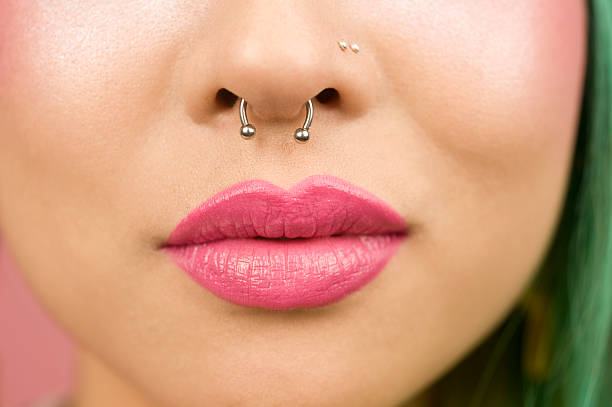Nose piercing, a popular form of body art, has been embraced by various cultures around the world for centuries. Whether for aesthetic reasons, cultural significance, or personal expression, getting a nose piercing is a decision that comes with the responsibility of proper aftercare. Ensuring a smooth and infection-free healing process is crucial, as neglect can lead to complications, prolonged healing times, and unsatisfactory outcomes.
This guide aims to provide comprehensive aftercare tips, from cleaning instructions to lifestyle adjustments, to help you through the healing journey of your new nose piercing. Follow these steps carefully to maintain the health and beauty of your piercing as it heals.
Importance of Nose Piercing Aftercare:

Nose piercing, as a form of body modification, has grown in popularity due to its aesthetic appeal and ability to offer a unique form of self-expression. However, the journey towards a fully healed and aesthetically pleasing nose piercing is heavily reliant on proper aftercare practices. These practices are crucial for not only ensuring the aesthetic outcome of the piercing but also for maintaining overall health and preventing complications.
Proper Aftercare Leads to Successful Piercing Experiences
The success of a nose piercing is significantly determined by the aftercare regimen followed during the healing process. Proper aftercare helps to accelerate healing, ensures the piercing heals correctly, and minimizes the likelihood of the piercing closing prematurely. It involves a series of routine cleanings, careful monitoring of the piercing site for any signs of infection, and avoiding certain activities or substances that could irritate the piercing. Following a recommended aftercare routine helps to maintain the integrity of the piercing, ensuring that it heals beautifully and as intended.
Avoiding Infections and Complications Through Aftercare:
One of the primary reasons for emphasizing aftercare is the risk of infections and complications that can arise from improper or inadequate care. Nose piercings, like any open wound, are susceptible to bacteria and other pathogens that can lead to infections. These infections can range from minor to severe, potentially leading to scarring or the need for medical intervention. Additionally, improper aftercare can result in complications such as piercing bumps or keloids, which not only detract from the appearance of the piercing but can also be difficult to treat. By adhering to proper aftercare instructions, individuals can significantly reduce the likelihood of encountering these unwanted outcomes.
Understanding the Healing Process of Nose Piercings:
The healing process for nose piercings is not a one-size-fits-all situation. It varies depending on several factors, including the individual’s health, the type of piercing, and the aftercare regimen. Understanding this process is critical for recognizing what is normal during healing and what may indicate a problem.
Initial Healing Time and Stages
The healing process for a nose piercing typically takes anywhere from 4 to 6 months, although this can vary from person to person. Initially, it’s normal to experience some redness, swelling, and tenderness around the piercing site. During the first few weeks, the body begins to form new tissue around the piercing, which is an essential part of the healing process. It’s crucial during this time to follow aftercare instructions meticulously to support the body’s natural healing mechanisms.
Signs of Healing vs. Infection
Distinguishing between the normal signs of healing and signs of infection is essential for anyone with a new nose piercing. Signs of normal healing include a gradual decrease in redness, swelling, and tenderness around the piercing site, as well as the formation of a crust around the jewelry, which should not be removed forcibly. On the other hand, signs of infection may include persistent or increasing redness, swelling, severe pain, yellow or green discharge, and in some cases, fever. If you notice any signs of infection, it is important to seek professional medical advice as soon as possible to prevent complications. By being informed of what to expect and what to watch out for, individuals with new nose piercings can better navigate the healing process, ensuring a healthier and more aesthetically pleasing outcome.
Cleaning Instructions for Nose Piercings:
Proper cleaning is crucial to the healing of a nose piercing. It not only aids in preventing infections but also ensures that the healing process progresses smoothly. Here, we delve into the recommended cleaning solutions, the step-by-step process of cleaning your nose piercing, and the frequency at which cleaning should be carried out.
Recommended Cleaning Solutions
The optimal solution for cleaning a nose piercing is a saline solution. You can either purchase a premade saline solution specifically designed for piercings or make your own by dissolving 1/4 teaspoon of non-iodized sea salt into one cup (8 oz) of warm distilled or bottled water. It’s essential to avoid using harsh chemicals like alcohol or hydrogen peroxide, as these can irritate the skin and hinder the healing process.
Step-By-Step Cleaning Process
- Wash your hands: Always start by thoroughly washing your hands with antibacterial soap to avoid introducing bacteria to the piercing site.
- Prepare the saline solution: If you’re making your saline solution, ensure that the salt is completely dissolved in the warm water.
- Apply the solution: Soak a clean, lint-free cloth or paper towel in the saline solution and gently press it against your nose piercing for a few minutes. This helps to soften and remove any crusted discharge around the piercing.
- Rinse and dry: After cleaning, rinse the area with clean water and gently pat it dry with a clean, disposable paper towel. Avoid using cloth towels as they can harbor bacteria.
- Avoid twisting or moving the jewelry: This can irritate the piercing and hinder the healing process.
Frequency of Cleaning
For optimal healing, clean your nose piercing with saline solution twice a day—once in the morning and once at night. Overcleaning can irritate the piercing, so it’s crucial to stick to this frequency. Remember, consistency is key to a smooth healing process.
Dos and Don’ts of Nose Piercing Aftercare:
Following the right aftercare practices is essential for the well-being of your new nose piercing. Here, we explore the recommended practices for a smooth healing process and detail common mistakes you should avoid to prevent complications.
Recommended Practices for A Smooth Healing Process
- Maintain good hygiene: Always wash your hands before touching your nose piercing. This simple practice can prevent infection.
- Keep the area clean and dry: Following the cleaning instructions provided above can significantly reduce the risk of infection and promote a faster healing process.
- Be patient with your body: The healing process for a nose piercing can take anywhere from four to six months. Give your body the time it needs to heal properly.
Avoiding Common Mistakes That Can Hinder Healing:
- Don’t overclean: Cleaning your piercing more than twice a day can irritate the site and delay healing.
- Avoid swimming: Pools, lakes, and hot tubs can harbor bacteria that can cause infections. It’s best to avoid swimming until the piercing has fully healed.
- Don’t change the jewelry prematurely: Switching out your nose jewelry too soon can cause irritation and infection. Wait until the piercing has fully healed before making any changes.
- Resist touching the piercing unnecessarily: Playing with or frequently touching your piercing can introduce bacteria and lead to infections.
By following these cleaning instructions and adhering to the dos and don’ts of nose piercing aftercare, you can ensure a smoother and quicker healing process, enjoying your new piercing with minimal complications.
Remedies for Common Nose Piercing Issues:
When you’re navigating the healing process of a nose piercing, certain issues can emerge. It’s important to know how to handle irritation and swelling, and when to seek professional advice. With the right approach, you can ensure a smoother healing journey.
Dealing with Irritation and Redness
Irritation and redness are common in the early days of a nose piercing. To alleviate these symptoms, ensure you’re following a proper cleaning routine. Use a saline solution twice a day to gently clean the area. Avoid using harsh chemicals or alcohol-based products as they can exacerbate the irritation. It’s also crucial to avoid touching or twisting the jewelry, which can introduce bacteria and increase irritation. If your bedding or clothing frequently comes into contact with your piercing, consider changing them more often to maintain a clean environment.
Handling Swelling and Crust Formation
Swelling and the formation of crust around the piercing site are typical responses to the body’s healing process. To manage swelling, apply a clean, cold compress gently to the area for short periods. Ensure you’re not applying ice directly to the skin to avoid tissue damage. To deal with crust formation, softening the crust with a warm saline soak can be helpful. After soaking, you can gently wipe away the softened crust with a clean, damp cloth. Remember, never pick at the crust as this can lead to scarring and delayed healing.
Consulting a Professional for Severe Issues
If you experience severe pain, excessive swelling, or signs of an infection such as pus discharge or a fever, it’s time to consult a professional. Piercers and medical healthcare providers can offer guidance and, if necessary, prescribe treatment to address the issue. It’s important to not self-medicate or ignore symptoms that persist or worsen over time. Professional insight can ensure your healing process is back on the right track, preventing longer-term complications.
Lifestyle Adjustments for Better Healing:
Avoiding Activities That Can Irritate the Piercing
To ensure your nose piercing heals smoothly, it’s crucial to avoid any activities that can irritate the area. This includes touching or twisting the jewelry unnecessarily, which can introduce bacteria and cause infection. Additionally, swimming in pools, lakes, or the ocean should be avoided during the initial healing period, as these waters can contain harmful microorganisms. It’s also advisable to shield your nose from harsh skincare products or cosmetics that might irritate the sensitive skin around the piercing.
Choosing the Right Products for Sensitive Skin
When caring for a new piercing, selecting skincare and makeup products designed for sensitive skin can make a big difference in the healing process. Look for hypoallergenic products free of alcohol, parabens, and fragrances, which can reduce the risk of irritation and allergic reactions. Using a gentle, fragrance-free soap for cleaning the piercing area is also recommended. Read product labels carefully to ensure they’re suitable for your newly pierced skin.
Maintaining Overall Hygiene for Faster Healing
Maintaining a high level of personal hygiene is paramount for the speedy healing of your nose piercing. This includes regularly washing your hands with soap and water before touching or cleaning the piercing. Ensure you’re changing your pillowcases frequently and keeping your phone or anything else that comes near your face clean to minimize the introduction of bacteria. Additionally, maintaining a healthy diet and staying hydrated can support your body’s natural healing processes, leading to a faster and more comfortable recovery.

